Serving 123 students in grades Kindergarten-8, Friendship Public Charter School Online ranks in the top 30% of all schools in District Of Columbia for overall test scores (math proficiency is top 30%, and reading proficiency is top 30%).
The percentage of students achieving proficiency in math was 30-34% (which was higher than the District Of Columbia state average of 25%). The percentage of students achieving proficiency in reading/language arts was 35-39% (which was higher than the District Of Columbia state average of 26%).
The student:teacher ratio of 21:1 was higher than the District Of Columbia state level of 11:1.
Minority enrollment was 78% of the student body (majority Black), which was lower than the District Of Columbia state average of 87% (majority Black).
School Overview
School Type
Grades Offered
Grades Kindergarten-8
Total Students
123 students
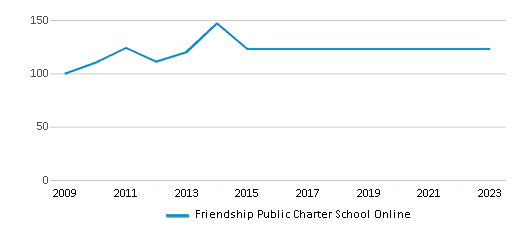
Total Classroom Teachers
6 teachers
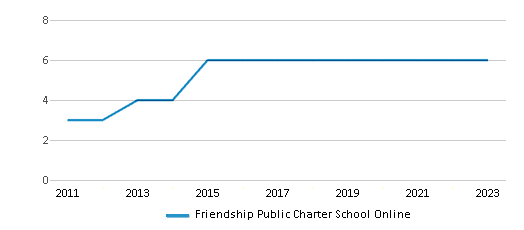
Students by Grade
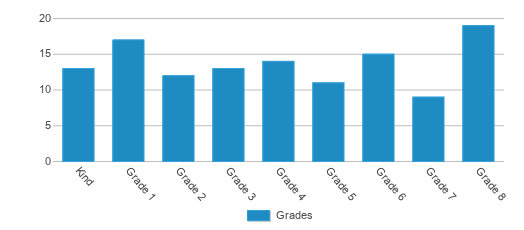
School Rankings
Math Test Scores (% Proficient)
(14-15)30-34%
25%
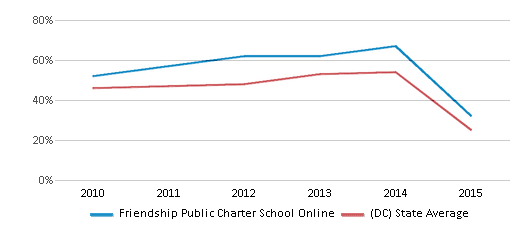
Reading/Language Arts Test Scores (% Proficient)
(14-15)35-39%
26%
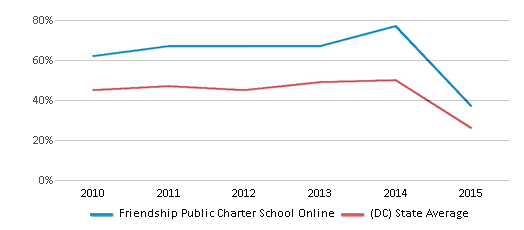
Student : Teacher Ratio
21:1
11:1
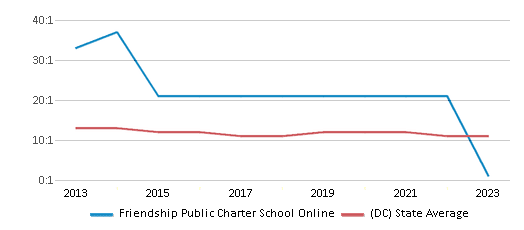
American Indian
n/a
n/a
Asian
n/a
2%
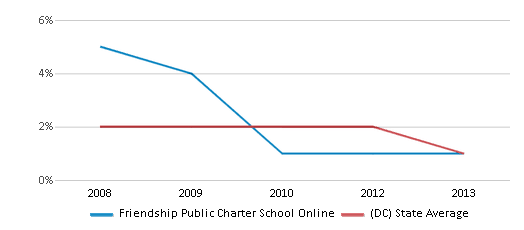
Hispanic
9%
19%
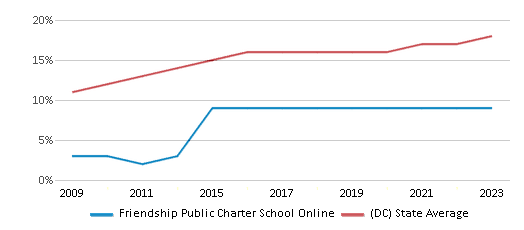
Black
68%
63%
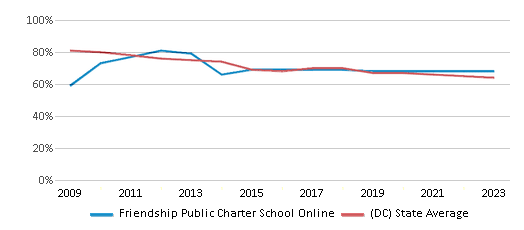
White
22%
13%
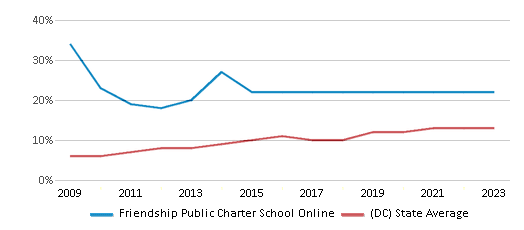
Hawaiian
1%
n/a
Two or more races
n/a
3%
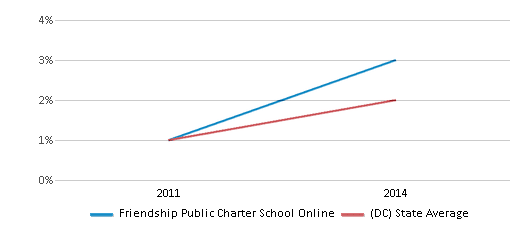
All Ethnic Groups
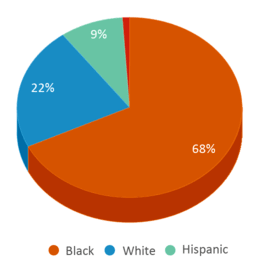
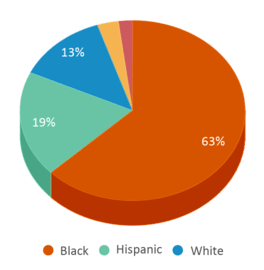

Eligible for Free Lunch
45%
49%
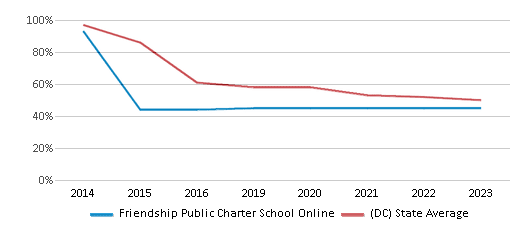
Eligible for Reduced Lunch
14%
8%
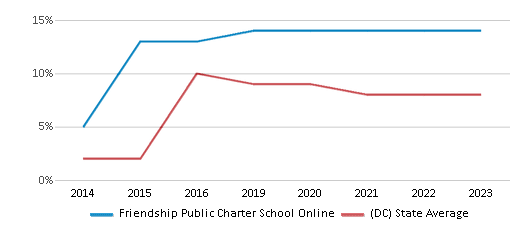
School Statewide Testing
School District Name
Community Academy PCS School District
Source: National Center for Education Statistics (NCES), DC Dept. of Education
School Notes
- Friendship Public Charter School Online is a unique partnership between the Friendship Public Charter School and K12. Our students are proud members of the Friendship family who engage with their education in a virtual environment. Friendship PCS Online offers the award-winning K12 curriculum in an effort to provide our students with current, meaningful, and interactive lessons in reading, language arts, mathematics, history, science, music, and art. Friendship PCS Online even offers World Language courses infive languages, including Spanish, German, French, Latin, and Chinese!
- Our students range from kindergarten to grade 8, and are assisted by highly qualified, motivated teachers both virtually and in person. Our academic leaders and teachers also support parents or other adults in the home as they take on an important role as a student's "learning coach." Although many of the lessons and learning activities occur online and in the home, Friendship Public Charter School Online students are often brought together through face-to-face learning sessions at the Nicholson Street campus. Our students and families are also invited and encouraged to attend a wide variety of fun and educational family outings and field trips each month.
- For more information please give us a call at866.339.8742.
Frequently Asked Questions
What percent of students have achieved state testing proficiency in math and reading?
30-34% of students have achieved math proficiency (compared to the 25% DC state average), while 35-39% of students have achieved reading proficiency (compared to the 26% DC state average).
How many students attend Friendship Public Charter School Online?
123 students attend Friendship Public Charter School Online.
What is the racial composition of the student body?
68% of Friendship Public Charter School Online students are Black, 22% of students are White, 9% of students are Hispanic, and 1% of students are Hawaiian.
What is the student:teacher ratio of Friendship Public Charter School Online?
Friendship Public Charter School Online has a student ration of 21:1, which is higher than the District Of Columbia state average of 11:1.
What grades does Friendship Public Charter School Online offer ?
Friendship Public Charter School Online offers enrollment in grades Kindergarten-8
What school district is Friendship Public Charter School Online part of?
Friendship Public Charter School Online is part of Community Academy PCS School District.
Recent Articles

What Is A Charter School?
Explore the world of charter schools in this comprehensive guide. Learn about their history, how they operate, and the pros and cons of this educational innovation. Discover key facts about charter schools, including admission policies, demographics, and funding, as well as what to look for when considering a charter school for your child.

10 Reasons Why High School Sports Benefit Students
Discover the 10 compelling reasons why high school sports are beneficial for students. This comprehensive article explores how athletics enhance academic performance, foster personal growth, and develop crucial life skills. From improved fitness and time management to leadership development and community representation, learn why participating in high school sports can be a game-changer for students' overall success and well-being.

February 05, 2025
Understanding the U.S. Department of Education: Structure, Impact, and EvolutionWe explore how the Department of Education shapes American education, from its cabinet-level leadership to its impact on millions of students, written for general audiences seeking clarity on this vital institution.





